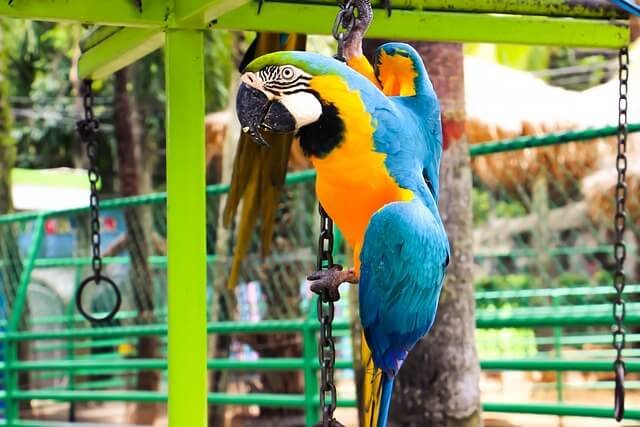How to Train Your Parrot to Talk: Tips and Tricks

Unlock the secrets to successful parrot training! Discover expert tips to teach your feathered friend impressive perching and parrot tricks.
Table of Contents
Parrots are known for their fascinating ability to mimic human speech, making them popular pets among bird enthusiasts. Training a parrot to talk is not only a rewarding experience but also a great way to bond with your feathered friend. In this step-by-step guide, we will walk you through the process of training your parrot to develop impressive vocal skills.
Preparing the Training Environment
Before diving into the training process, it is crucial to set up the right environment for your parrot to thrive. Choose a quiet and comfortable space where you can establish a dedicated training area. This space should be free from distractions and disturbances that might interrupt your training sessions.
Create a positive and stimulating environment for your parrot by placing toys, perches, and interesting objects nearby. Parrots are highly intelligent and curious creatures, so providing them with an engaging space will support their overall training progress.
Gather the necessary training tools, such as treats, a clicker, a target stick, and toys. These tools will help you reinforce positive behavior and make the training experience more enjoyable for your parrot.
Building Trust and Bonding
Establishing trust and building a strong bond with your parrot is essential for successful training. Spend quality time with your parrot, engaging in activities that allow for positive interactions. Grooming, playing, and talking softly to your parrot will help them feel comfortable and secure in your presence.
Create a consistent routine that incorporates regular training sessions. By establishing a predictable schedule, your parrot will feel more at ease during training and be more responsive to the learning process. Always be mindful of your parrot’s body language and signs of stress or discomfort.
Teaching Basic Commands
Start the training process by encouraging your parrot to mimic simple sounds or whistles. Pick a sound that is easy for your parrot to replicate, such as a short whistle or a single syllable sound. Repeat this sound consistently, gradually increasing the training duration over time.
Utilize a clicker and treats to reinforce positive behavior. When your parrot successfully mimics the desired sound, immediately use the clicker to mark the behavior and give them a treat as a reward. This positive reinforcement will help your parrot associate the action with a reward, motivating them to continue learning.
Introducing Words and Phrases
Once your parrot has become comfortable with mimicking sounds, it’s time to introduce words and phrases. Start by selecting a few keywords or short phrases that you want your parrot to learn. Begin by repeating these words or phrases slowly and distinctly.
A useful technique is to associate words with specific actions or objects. For example, when showing your parrot their favorite toy, say the word “toy” clearly and consistently. By making these associations, your parrot will begin to understand the meaning behind the words they are mimicking.
Encouraging Vocalization
Encouraging vocalization in your parrot involves providing them with sources of inspiration. Play recorded human speech or music in their presence to stimulate their desire to mimic sounds. Engage in conversations with your parrot, asking them questions or making statements, and waiting for their response. This interactive approach encourages your parrot to develop their own vocal skills.
Additionally, social interactions play a crucial role in reinforcing and supporting your parrot’s vocalization efforts. Spend time around your parrot, talking to them and creating an environment that encourages communication. Celebrate and reward any attempts or progress made by your parrot, regardless of how small they may seem.
Handling Challenges
Training a parrot to talk can sometimes come with challenges. Some parrots may be naturally shy or reluctant to mimic sounds. If you encounter such obstacles, remember to approach the training process with patience and persistence.
Modify your training techniques according to your parrot’s individual personality. Some parrots may respond better to shorter training sessions, while others may require more frequent but shorter interactions. Pay attention to your parrot’s cues and adjust the training approach accordingly.
If you find yourself struggling, don’t hesitate to seek professional guidance or join online parrot training communities. These resources can provide valuable tips, advice, and support from experienced parrot trainers and enthusiasts.
Maintaining Consistency and Patience
Consistency is key when training your parrot to talk. Implement a daily training schedule and stick to it. Gradually increase the duration and complexity of the training sessions as your parrot progresses. Be patient and understanding, as each parrot learns at their own pace.
Celebrate every small achievement along the way. Remember that training can sometimes be a slow process, but even the tiniest steps forward are significant milestones in your parrot’s journey to becoming a proficient talker.
Expanding Vocabulary and Refining Skills
As your parrot becomes more proficient in mimicking sounds and words, you can start introducing new vocabulary and phrases. Choose words or phrases that suit your parrot’s unique personality and expand their repertoire gradually.
Encourage spontaneous vocalization by creating an environment rich in sound stimuli. Reinforce creative mimicry by responding positively whenever your parrot tries to imitate a new sound or word. Keep strengthening your parrot’s vocal skills through ongoing practice and reinforcement.
Conclusion
Training your parrot to talk is a fulfilling and captivating experience that can deepen the bond between you and your feathered companion. By following the step-by-step guide outlined above, you are equipped with the knowledge and techniques necessary to embark on this exciting journey.
Remember, patience, consistency, and positive reinforcement are the keys to successful parrot training. Enjoy the process, celebrate small victories, and savor the remarkable progress your parrot makes as they develop their vocal skills. Before you know it, your parrot will be talking up a storm, sharing in conversations, and captivating your heart with their charming personality.






